Contents
- Introduction
- Preface
- Overview
- Relief Valve
- LECTURE 1: Why We Are In The Dark About Money
- LECTURE 2: The Con
- LECTURE 3: The Vatican-Central to the Origins of Money & Power
- LECTURE 4: London The Corporation Origins of Opium Drug Smuggling
-
LECTURE 5: U.S. Pirates, Boston Brahmins Opium Drug Smugglers
- THE BOSTON BRAHMINS
- Pirates Profiteers Banksters Traders Transfers
- Pirates
- White Slavers, Cargo, Property, Auctions, Amazing Grace
- $ Colonial Labor: Indentured Servants
- England to Philadelphia Slave Trade and Opium
- Extract from Charter of Freedoms and Exemptions to Patroons 1629
- The Definitive Treaty of Peace
- Pennsylvania Charter of Privileges 28 October 1701
- Opium Trade -- American Drug Smuggling Pirates
- Opium In America
- 1% Power Elite Networks
- 1% Elite Networks Bush & The CIA
- BEFORE Skull & Bones
-
SKULL AND BONES
- Academia, Fraternity, Feeder Schools
- Yale and China
- Order of Skull and Bones Chains of Influence
- Tracing the History of Skull and Bones
- Russell Trust
- White Shoe Law Firms
- Kleiner Perkins Caufield & Byers
- Ruth Avery Hyde Paine
- Skull and Bones Secrets
- $uper Rich
- Prescott Bush - Trading With The Enemy Act
- George Bush, Skull & Bones and the New World Order
- Dulles Family and Harvard's Pig Club
- Du Pont Loves Monoplies, Nazis and Trust Funds
- Skull & Bones and the American National Red Cross
- Caribbean Pirates in the American South
- Who Were the Tories
- The Golden Age of Imperialism Opium Act 1908
- Global Dominance Groups
- The New World Order
- Characteristics of Fascism
- War on drugs
- Lecture 5 Objectives and Discussion Questions
- LECTURE 6: The Shady Origins Of The Federal Reserve
- LECTURE 7: How The Rich Protect Their Money
- LECTURE 8: How To Protect Your Money From The 1% Predators
- LECTURE 9: Final Thoughts
The History of Skull and Bones Begins at Yale
Yale is the intersection of Opium Drug Smuggling Pirates,
the American 1% and Espionage [ CIA ]
The Order of the Skull and Bones at Yale University.
In 1680, Elihu married a widow Catherine Hynmer who had four children by her first husband. Catherine was an heiress with a large fortune. They had their own four children as well. They consisted of three daughters and a son who died shortly after birth. Catherine Hynmer returned to England in 1689 and that was effectively the end of their marriage. Elihu returned to England in 1699 with his fortune. Elihu Yale was a benefactor to Yale University.
2015 Yale Has Almost $1 Billion in Cash Waiting to Be Invested
Yale University, one of the world’s wealthiest universities, was holding 3.5 percent of its $23.9 billion endowment in cash as of June 30, up from 1.6 percent the previous year, the school said in a report.
Roots of American Espionage
Culper Ring (Revolutionary War)
The Ring's task was to send messages to General George Washington about the activities of the British in New York.
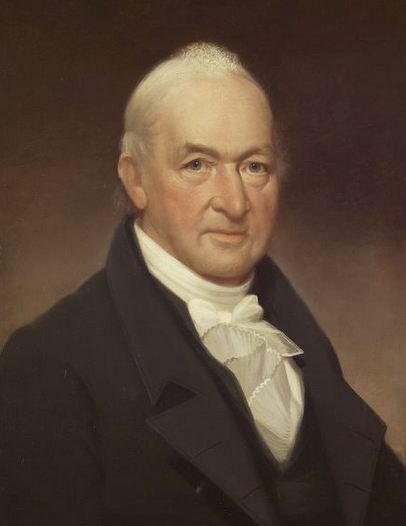
Benjamin Tallmadge – Dragoon Commander and Intelligence Chief born on Long Island in 1754 and graduated from Yale College in 1773. He was a classmate of American Revolutionary War spy Nathan Hale. Eventually he would become Chief Intelligence Officer for Washington. Talmadge died in March 1835 and is buried in East Cemetery, Litchfield, Connecticut.
In 1780 Hale's classmate Benjamin Tallmadge (far left), by then chief of General Washington's agents spying on British headquarters in New York City, took charge of the captive Major John André, caught with plans from Benedict Arnold for the surrender of West Point. When André asked what would happen to him, Tallmadge reminded him that four years earlier the British had hanged "a much loved classmate in Yale College by the name of Nathan Hale… and similar will be your fate." This entry in Tallmadge's memoirs supports the belief - widely shared but never officially documented - that the popular André, who pleaded for an officer's death by firing squad, was instead hanged as retaliation for Hale.
Robert Townsend (alias: Samuel Culper, Jr.) gathered intelligence in British occupied New York City by Abraham Woodhull (alias: Samuel Culper, Sr.). It was then passed to Austin Roe for transportation to Setauket, Long Island. Once in Setauket, the intelligence was carried across the sound by Caleb Brewster to Major Tallmadge in Connecticut.
He served in U.S. House of Representatives from 1801-1817
Washington thought highly of Townsend's reports, according to letters he later wrote to Tallmadge. Although the British captured a Washington letter to spy Abraham Woodhull that referred to "Culper," they never figured out his identity and Townsend took his secret with him to the grave in 1838.
His double life remained a secret until the 20th century when Long Island historian Morton Pennypacker sought to match the handwriting in "Culper Jr's" letters to Washington with the script contained in ledgers and other documents found in Oyster Bay, belonging to an obscure New York and Long Island merchant, who turned out to be Townsend. Pennypacker retained the services of graphologist Albert S. Osborn to make this determination. This discovery by Pennypacker was first announced at a meeting of the New York State Historical Society on September 27, 1930, when he read a paper that he prepared on Nathan Hale and Robert Townsend (source: The New York Times, September 28, 1930)
The Ring's task was to send messages to General George Washington about the activities of the British in New York. They operated mostly in New York, Long Island and Connecticut. The Ring conducted covert operations until after the end of the American Revolutionary War, but its heyday was between 1778 and 1781. Secrecy was so strict Washington did not know the identity of all the operatives. The general public was not aware of the Ring's existence until the 1930s. "Culper Junior’s" identity was discovered in 1939, with the discovery of a trunk of old letters in the Townsend family home.
"Most accurate and explicit intelligence" resulted from the work of Abraham Woodhull on Long Island and Robert Townsend in British-occupied New York City. Their operation, known as the Culper Ring from the operational names used by Woodhull (Culper, Sr.) and Townsend (Culper, Jr.), effectively used such intelligence tradecraft as codes, ciphers and secret ink for communications; a series of couriers and whaleboats to transmit reporting; at least one secret safe house, and numerous sources. The network was particularly effective in picking up valuable information from careless conversation wherever the British and their sympathizers gathered.
One female member of the Culper Ring, known only by her codename "355," was arrested shortly after Benedict Arnold's defection in 1780 and evidently died in captivity. Details of her background are unknown, but 355 (the number meant "lady" in the Culper code) may have come from a prominent Tory family with access to British commanders and probably reported on their activities and personalities. She was one of several females around the debonaire Major André, who enjoyed the company of young, attractive, and intelligent women. Abraham Woodhull, 355's recruiter, praised her espionage work, saying that she was "one who hath been ever serviceable to this correspondence." Arnold questioned all of André's associates after his execution in October 1780 and grew suspicious when the pregnant 355 refused to identify her paramour. She was incarcerated on the squalid prison ship Jersey, moored in the East River. There she gave birth to a son and then died without disclosing that she had a common-law husband–Robert Townsend, after whom the child was named.
Nathan Hale and Tallmadge were close friends at Yale, and Tallmadge's entry into the secret world was not accidental, nor did it begin with the Culper Ring in 1778. As early as 1777, Tallmadge acted as the operative John Clark's contact in Connecticut when Clark was based on Long Island. Before that, he worked for the spymaster Nathaniel Sackett, who was later fired.
THE ONLY COUNTRIES ENGLAND DIDN'T INVADE [ in white ]
The British invaded almost every part of the world for the sake of exploiting resources. China became a main target for Britain because of its many goods that the British coveted. Britail ulimately pushed Opium on China against its will so that it could get the goods it wanted from China without having to pay in silver. The richest U.S. drug merchants, including a Skull and Bones founder, continued this racket.
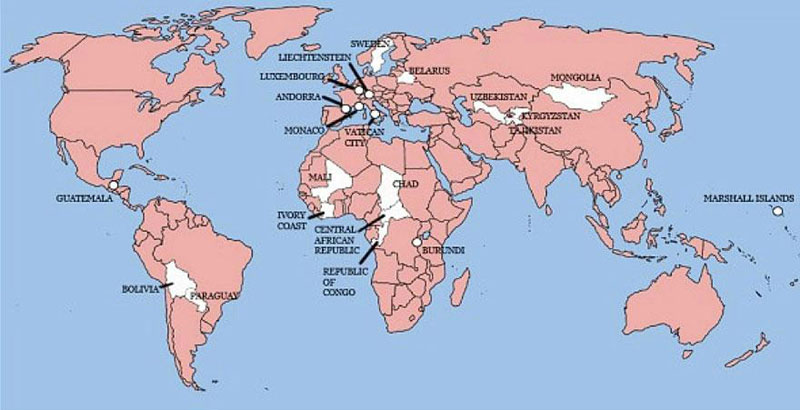
Skull and Bones was founded in 1832 after a dispute among Yale's debating societies, Linonia, Brothers in Unity, and the Calliopean Society, over that season's Phi Beta Kappa awards; its original name was "the Order of Skull and Bones."[4][5]
The first extended description of Skull and Bones, published in 1871 by Lyman Bagg in his book Four Years at Yale, noted that "the mystery now attending its existence forms the one great enigma which college gossip never tires of discussing."[6] Brooks Mather Kelley attributed the secrecy of Yale senior societies to the fact that underclassmen members of freshman, sophomore, and junior class societies remained on campus following their membership, while seniors naturally left.[7]
ORIGINAL PLAYERS
THE 1%
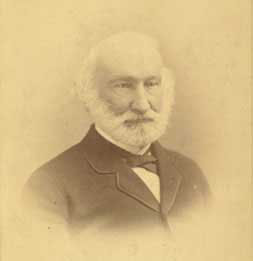
Col. WH Russell in his later years
William H. Russell (Skull &Bones; co-founder-1833)
His cousin was Samuel Russell who formally established Russell & Co. on January 1, 1824 for the purpose of acquiring opium and smuggling it to China.
Russell & Co. merged with the #1 number one US Opium Smuggler, the J. & T.H. Perkins "Boston Concern" in 1829.
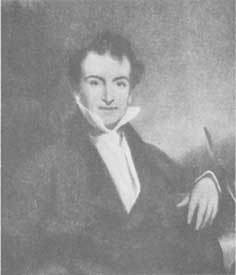
Samuel Russell of Middleton, Connecticut
Opium smuggling didn't just make money. At times, opium was money. Opium built empires and had a hand in financing much of the world's infrastructure.
By the mid-1830s the opium trade had become "the largest commerce of its time in any single commodity, anywhere in the world." Russell & Co. and the Scotch firm Jardine-Matheson, then the world's largest opium dealer working together were known as the "Combination."
George HW Bush (S&B 1948) was born in Milton, Massachusetts not far from the historic home of Robert Bennett Forbes, a Russell partner. All the 1% American, European and Chinese family fortunes were built on the "China"(opium) trade. Yes, they sold porcelain, tea, silks and other items at home in the US, but they "needed" the trade in opium for silver to pay for the desired goods and—opium smuggling returned "handsome" profits.
 Skull and Bones is a secret society at Yale University in New Haven, Connecticut, USA. The society's alumni organization, which owns the society's real property and oversees the organization, is the Russell Trust Association, named for General William Huntington Russell,[1] who co-founded Skull and Bones with classmate Alphonso Taft. The Russell Trust was founded by Russell and Daniel Coit Gilman, member of Skull and Bones and later president of the University of California, first president of Johns Hopkins University, and the founding president of the Carnegie Institution. The society is known informally as "Bones", and members are known as "Bonesmen".[2]
Skull and Bones is a secret society at Yale University in New Haven, Connecticut, USA. The society's alumni organization, which owns the society's real property and oversees the organization, is the Russell Trust Association, named for General William Huntington Russell,[1] who co-founded Skull and Bones with classmate Alphonso Taft. The Russell Trust was founded by Russell and Daniel Coit Gilman, member of Skull and Bones and later president of the University of California, first president of Johns Hopkins University, and the founding president of the Carnegie Institution. The society is known informally as "Bones", and members are known as "Bonesmen".[2]
During the senior year, each Skull and Bones class meets every Thursday and Sunday night.[3]
President William Howard Taft, President George H. W. Bush, his son, President George W. Bush, and the latter's 2004 Presidential opponent, Senator John Kerry, Stephen A. Schwarzman, Founder of Blackstone, Austan Goolsbee, Chairman of President Obama's Council of Economic Advisers, Harold Stanley, co-founder of Morgan Stanley and Frederick W. Smith, Founder of Fedex are all reported to be members.
Stephen A. Schwarzman, Founder of Blackstone, is one of Mr. Trump’s closest business advisers. Wu Xiaohui, the chairman of Anbang Insurance Group, was taken away by the police on Friday in Beijin. His detention has significant implications for China and the United States. Anbang, which claims to have almost $300 billion in assets, had recently been on a global buying spree, acquiring the Waldorf Astoria hotel in Manhattan for almost $2 billion in 2013, among other businesses. After Failed Talks With Kushner, More Trouble for a Chinese Tycoon MAY 1, 2017 Kushners, Trump In-Laws, Weigh $400 Million Deal With Chinese Firm MARCH 14, 2017 A Chinese Mystery: Who Owns a Firm on a Global Shopping Spree? SEPT. 1, 2016 Anbang is also one of the biggest issuers of speculative wealth management products in China.
in November met with Jared Kushner, Mr. Trump’s son-in-law and a top adviser, in a bid to buy a stake in a Manhattan office building partly owned by Mr. Kushner’s family company. The deal was eventually abandoned after media coverage that highlighted a perceived conflict of interest. Mr. Kushner’s purview at the White House includes relations with China. Anbang has taken the money it raised from Chinese savers and invested much of it abroad. Last year, Anbang spent more than $6 billion for a collection of luxury hotels across the United States. The seller of those hotels was the Blackstone Group, whose chairman and chief executive, Stephen A. Schwarzman, is one of Mr. Trump’s closest business advisers. <more>https://www.nytimes.com/2017/06/13/business/dealbook/insurance-china-anbang.html?_r=0
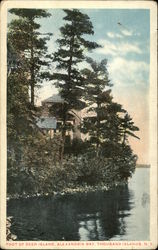 Skull and Bones owns an island in the St. Lawrence River in upstate New York named Deer Island:
Skull and Bones owns an island in the St. Lawrence River in upstate New York named Deer Island:
The 40 acre retreat is intended to give Bonesmen an opportunity to "get together and rekindle old friendships."
Bonesman say that to call the island "rustic" would be to glorify it. "It's a dump, but it's beautiful."
— Alexandra Robbins,TheAtlantic.com
List of Skull and Bones members
Judy Schiff, Chief Archivist at the Yale University Library, has written: "The names of (S&B's) members weren't kept secret, that was an innovation of the 1970s, but its meetings and practices were. The secrecy seems to have attracted fascination and curiosity from the start." While resourceful researchers could assemble member data from these original sources.
List of the 1920 delegation of Skull and Bones, including classmates and co-founders of TIME magazine, Briton Hadden and Henry Luce
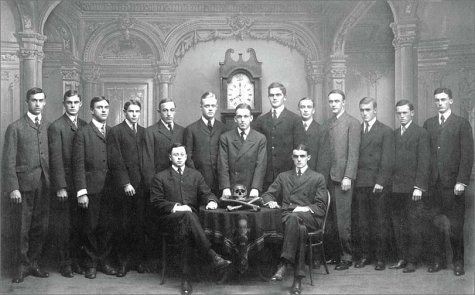 Yale became coeducational in 1969, but Skull & Bones remained all-male at the behest of the Russell Trust Association. The Class of 1991 disregarded the Trust and tapped seven female members for membership in the next year's class.[8] The Trust responded by changing the locks on the "Tomb"; the Bonesmen had to meet at the building of Manuscript Society.[8] A mail-in vote by living members decided 368-320 to permit going co-ed, but a group of alumni led by William F. Buckley obtained a temporary restraining order to block the move, arguing that a formal change in bylaws was needed.[8][9] Other alumni, such as John Kerry, spoke out in favor of admitting women, and the dispute even ended up on The New York Times editorial page.[8][10] A second vote of alumni in October 1991 agreed to accept the Class of 1992, and the lawsuit was dropped.[8][11]
Yale became coeducational in 1969, but Skull & Bones remained all-male at the behest of the Russell Trust Association. The Class of 1991 disregarded the Trust and tapped seven female members for membership in the next year's class.[8] The Trust responded by changing the locks on the "Tomb"; the Bonesmen had to meet at the building of Manuscript Society.[8] A mail-in vote by living members decided 368-320 to permit going co-ed, but a group of alumni led by William F. Buckley obtained a temporary restraining order to block the move, arguing that a formal change in bylaws was needed.[8][9] Other alumni, such as John Kerry, spoke out in favor of admitting women, and the dispute even ended up on The New York Times editorial page.[8][10] A second vote of alumni in October 1991 agreed to accept the Class of 1992, and the lawsuit was dropped.[8][11]
Skull and Bones selects new members every spring as part of Yale University's "Tap Day"; held on April 15, 2010. Every year, Skull and Bones selects fifteen men and women of the junior class to join the society. Skull and Bones traditionally "tapped" those that it viewed as campus leaders and other notable figures for its membership. Traditionally, groups such as the Delta Kappa Epsilon fraternity, Yale Political Union, and Yale Daily News were well represented.
Delta Kappa Epsilon fraternity and Yale's handling of sexual misconduct, has released its first report describing the complaints in the face of criticism of the way it had dealt with some cases particularly those involving members and pledges of the Delta Kappa Epsilon, Yale imposed a five-year suspension from the use of campus facilities on the fraternity, which had been involved in highly publicized instances of harassment. 2/1/12
In addition, captains of various athletics teams are also considered. Bones began tapping Jewish students in the early fifties and African-Americans in 1949.[14] Like its counterparts, Bones has diversified further its membership, in lockstep with the other six landed societies at Yale. Although, members have noted that no longer do they simply represent the strongest leaders on campus.[15] As one member of the 1991 class wrote to alumni, "Being a part of Bones is often an embarrassment, a source of ridicule and occasionally a good way to lose a friend...Very rarely is the Bones still seen as an honor, and never is it seen to represent the mainstream of Yale."[16] Skull and Bones has developed a reputation with some as having a membership that is heavily tilted towards the "Power Elite".[17]
Members are assigned nicknames. "Long Devil" is assigned to the tallest member; "Boaz" goes to any member who is a varsity football captain. Many of the chosen names are drawn from literature from religion and from myth. The banker Lewis Lapham passed on his nickname, "Sancho Panza", to the political adviser Tex McCrary. Averell Harriman was "Thor", Henry Luce was "Baal", McGeorge Bundy was "Odin", and George H. W. Bush was "Magog".[22]
S&B wealth came from international drug trafficking
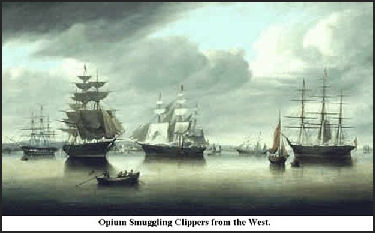 THE BACKGROUND OF THIS SECRET FRATERNITY
THE BACKGROUND OF THIS SECRET FRATERNITY
In 1985 Charlotte Iserbyt gave rosters to an economic historian, Antony C. Sutton,
who wrote a book on the group titled America's Secret Establishment: An Introduction to the Order of Skull & Bones. The information was finally reformatted as an appendix in the book Fleshing out Skull and Bones, a compilation edited by Kris Millegan, published in 2003.
Among prominent deceased alumni were President William Howard Taft, Supreme Court Justice Potter Stewart,[41] "mother of the Central Intelligence Agency", Henry Stimson, U.S. Secretary of War (1940-1945), and United States Secretary of Defense, Robert A. Lovett, who directed the Korean War.
Boodleboys An old slang term for members of the Order of Skull and Bones
Etymology of boodle
Caboodle means a collection of objects, sometimes of people. It commonly turns up in the whole caboodle, meaning “the whole lot”. It’s recorded in the US from the middle of the nineteenth century. It’s probable that the word was originally boodle.
Gailic Sanas of Boodle
1833, "crowd;" 1858, "phony money," especially "graft money," actual or potential (1883), both Amer.Eng. slang, either or both based on bundle, or from Du. boedel "property."
Boodle is familiar as the relatively modern US word for money illegally obtained, particularly linked to bribery and corruption. This is usually suggested as coming from the Dutch boedel, “inheritance, household effects; possessions”.
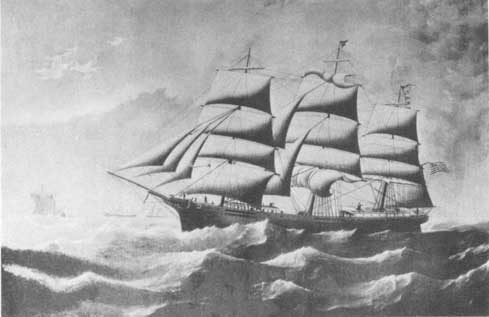
The Charmer, China Trade Clipper Ship launched 1854 built in Newburyport, Massachusetts by Geo. W. Jackman for Bush & Wildes of Boston.
Hon'ble John's Band
"When we sold the Heathen nations rum and opium in rolls,
And the Missionaries went along to save their sinful souls."
The Old Clipper Days
--Julian S. Cutler
The Opium Trade
"If the trade is ever legalized, it will cease to be profitable from that time. The more difficulties that attend it, the better for you and us.-- Directors of Jardine-Matheson
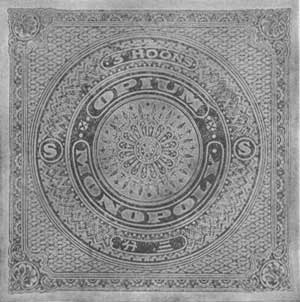
Wrapper for opium packet. Singapore c.1920
From Carl A Trocki's excellent book, Opium, Empire and the Global Economy(1999):
Drugs shaped Western Civilization. Once Skull and Bones members took over the trade, it changes the course of this Secret Society and its ability to influence the U.S.'s education, law, politics, and diplomacy.
"The trade in such drugs usually results in some form of monopoly which not only centralizes the drug traffic, but also restructures much of the affiliated social and economic terrain in the process. In particular two major effects are the creation of mass markets and the generation of enormous, in fact unprecedented, cash flows. The existence of monopoly results in the concentrated accumulation of vast pools of wealth. The accumulations of wealth created by a succession of historic drug trades have been among the primary foundations of global capitalism and the modern nation-state itself. Indeed, it may be argued that the entire rise of the west, from 1500 to 1900, depended on a series of drug trades."
<>
". . . the image of the "opium empire," a metaphor first offered by Joseph Conrad. It takes up the early history of opium and other "traditional drugs" such as tobacco and sugar and develops the paradigm of commercialized drug trades and ties that to the growth of European colonialism in the Americas and Asia . . ."
". . . links between drug trades, European colonial expansion, the creation of the global capitalist system and the creation of the modern state. Drug trades destabilized existing societies not merely because they destroyed individual human beings but also, and perhaps more importantly, because they have the power to undercut the existing political economy of any state. They have created new forms of capital; and they have redistributed wealth in radically new ways."
"Opium thus created a succession of new political and economic orders in Asia during the past two centuries. These included the state of the East India Company itself, the new Malay polities of island Southeast Asia, the colonial states of nineteenth-century Southeast Asia and the warlord regimes of post-Qing China as well as the Guomindang and communist states that arose out of that milieu. At the same time, the economies of the entire region were radically reoriented, or perhaps "re-occidented" would be a more appropriate word. India's opium production was brought under western control while China's domestic economy was opened to the west. Southeast Asia was first opened to western traders and then to western control. With the migration of Chinese labor, Southeast Asian economies were transformed into commodity-producing regimes focused on exporting to the industrializing western Powers. Underlying all of this, opium rearranged the domestic economies and pushed them down the path of mass consumption, which together with mass production, typified the "modern" economic order.
It is possible to suggest a hypothesis that mass consumption, as it exists in modern society, began with drug addiction. And, beyond that, addiction began with a drug-as-commodity. Something was necessary to prime the pump, as it were, to initiate the cycles of production, consumption and accumulation that we identify with capitalism. Opium was the catalyst of the consumer market, the money economy and even of capitalist production itself in nineteenth-century Asia.
Opium was the tool of the capitalist classes in transforming the peasantry and in monetizing their subsistence lifestyles. Opium created pools of capital and fed the institutions that accumulated it: the banking and financial systems, the insurance systems and the transportation and information infrastructures. Those structures and that economy have, in large part, been inherited by the successor nations of the region today."
british hand off illegal drug trade to select u.s. partners
The Dutch began trading opium in the 1610s, and not just as a profitable trade item. They used opium "as a useful means for breaking the moral resistance of Indonesians who opposed the introduction of their[Dutch] semi-servile but immensely profitable plantation system." In 1689, the English began trading at Canton and by the early 1770's they surpassed the Portuguese, Dutch and French to "became the leading supplier" to China. Because the Spaniards were allies of the America during the US War of Independence and thus no Spanish silver was available to pay for Chinese tea, the British monopolized the source of opium (India) and became the major trafficker. Later, increased competition and the hard facts that a tenth of the British tax base came from tea—and the tea came from China—gave an impetus for an increase in production and reduction in price of opium in the 1820s. "In other words; so that the British public could go on drinking their millions of gallons of tea each year, twice as many Chinese opium addicts (and for that matter, British opium addicts) had to be created." At first, it was thought in China that the English were buying the tea and rhubarb in such large quantities because the Chinese believed the British to be a constipated race because of their dietary inclusion of milk products.
Many historians discount the American activity in the opium trade, generally concentrating on the British and their mercantilist trading syndicate, the British East India Company. Because of the Navigation Act of 1651, Americans "were not permitted to sail their own ships to the Orient," they were required as colonists and subjects to buy all their Chinese goods in London from the East India Company. The East India Company's monopoly on the tea trade was more of a reason for the American Revolution than the cost of the tax. Through a political arrangement the tea was actually coming in for less than it could be bought in England. But the agitation of Samuel Adams, Ben Franklin and others had led to situation where ships were sent back to England unloaded, some cargoes rotted other shipments were destroyed—ala, the Boston Tea Party.
American smugglers, many of them prominent merchants, were already buying tea and Chinese merchandise from the Dutch and others. Smuggling was big business. The actual "tea tax" paid officially some years was very low in relation to tea that was drank. After the revolution, Americans were free to embark on their own mercantile adventures and when the East India Company outlawed their own ships from carrying opium, in 1805, American companies jumped right in. The War of 1812 caused some interruption of the trade but after the war the Americans held a major portion of the trade for many years.
The first US ship in the China Trade was the Boston sloop Harriet; it had traded American ginseng for Chinese tea. It didn't even get all they way to China, it traded its goods off the Cape of Good Hope. The Empress of China was especially built for the trade by Philadelphia's Robert Morris and first set sail towards China on Washington's birthday, February 22, 1784. It took ginseng and brought back teas, spices, silks, porcelains and other general household goods. There was interest in the products, a good profit was made and the China trade was off and running. Ginseng, seal and sea otter furs, and sandalwood were used to trade with the Chinese. Soon these resources were depleted and a new barter item was needed in lieu of silver—which the fledgling US had little of. In the late 1790's Smyrna (Izmer, today), Turkey a major source for opium began to become port of call for Americans.
Until 1792 part of the Perkins family shipping business, along with their Cabot relations was the slave trade. In 1789 Thomas H. Perkins first went to China with Elias Derby from Salem, Massachusetts. A "loyalist" cousin, who fled America during the War of Independence, George Perkins was a merchant in Symrna. With a solid "connection," a strong family framework and firm financial backing Perkins & Company became the leader in the American pack. It was a family affair. Thomas H. was brother-in-law of Russell Sturgis, an uncle to J.P. Cushing and brothers John M. and Robert B. Forbes. Joshua Bates, a partner in Baring Brothers Bank, handled the family business in London. He was married to a Sturgis. Russell Sturgis's grandson later became Chairman of the Board of Barings.
Perkins & Co. found that illegality both in nature and operation discouraged competition and used sporadic attempts by the Chinese Government to enforce their opium prohibition, "to [build] the machinery that allowed it to control the Canton market for Turkish opium." Perkins & Company became the first American firm to operate a "storeship" at Lintin in a new smuggling procedure. The opium was unloaded onto the "storeship," then the trading vessel would travel on to Canton with chits. The chits were then sold and the opium was retrieved later by the Chinese buyer. Smooth as silk—all illegal—but bribes were paid and business was good.
Samuel Russell and Phillip Ammidon came to Canton in 1824, Russell having first been there in 1818 as a business representative for a merchant house out of Providence R.I. Ammidon went on to India to serve as the firm's opium buyer. In "a series of accidents and coincidental decisions" Russell & Company acquired a "virtual" monopoly on the American portion of the trade in the 1830's. Other eastern merchants failed, died, or retired like John Jacob Astor. Perkins & Company, resident partner in Canton, Thomas T. Forbes was drown in August of 1829, and he carried a letter which gave Russell "charge of the firm's [Perkin's] business."
In the 1830's the price of opium went down and shipments of opium to China went up. The decade started out with four times the shipments of 1820 and by 1838 over ten times. The opium clipper—introduced by the Americans—with its ability to sail against the monsoons made three round-trip journeys within one year instead of taking up to two years. Profits were huge and there was a large flow of silver being introduced from China into booming western economies. In early 1837 there was a price-crash in the opium market and the speculators losses reverberated around the world in a financial panic in which specie became scarce both in Britain and the US.
August Belmont came to New York City in 1837, a stopover on his way to Havana, but stayed on in Gotham, buying securities, debts and property during the "Panic of 1837." Many say he was acting as an agent for the Rothschilds. Also in 1837 George Peabody, an old "China" trader—among other ventures—settled in London and brought into his sphere JS Morgan, progenitor of JP Morgan. Many Bonesmen were partners and principals in Morgan-related firms.
ONE OF A KIND ELITE SECRETIVE NETWORKSKULL AND BONES FACTS - alternate link
Samuel Russell of Middleton, Connecticut - The Boodle Boys slang for "the whole gang"
It was founded in 1832 by William Huntington Russell and Alphonso Taft, two students who were not admitted into Phi Beta Kappa at Yale University, in New Haven, Connecticut. The first Skull and Bones class, or "cohort", was in 1833. Skull and Bones is known by many names, including The Order of Death, The Order, The Eulogian Club, and Lodge 322. Initiates are most commonly known as Bonesmen, Knights of Eulogia, and Boodle Boys. The females who have recently been permitted to become members would be known as Boneswomen, Ladies of Eulogia, and Boodle Girls.In public, its corporate name is the Russell Trust Association. In 1999 it had assets of $4,133,246.
http://en.wikipedia.org/wiki/Russell_Trust_Association
Skull and Bones is the only secret society known to have a summer home and its own private island. This private island, one of the Thousand Islands lying in gray territorial area between the United States and Canada, was given to the Order by one of its early mysterious benefactor families who was associated with the secret society.
The Old Line American families and their descendants involved in the Skull & Bones are names such as:
Whitney, Perkins, Stimson, Taft, Wadsworth, Gilman, Payne, Allen, Bundy, Adams, Davidson, Pillsbury, Sloane, Weyerhaeuser, Harriman, Rockefeller, Lord, Brown, Bundy, Bush, Phelps, Forbes, John Kerry, McNamara.
* Henry Luce ('20), Time-Life
* Gifford Pinchot ('89), President Theodore Roosevelt's chief forester
* Frederick E. Weyerhaeuser ('96)
* Harold Stanley ('08), founder of Morgan Stanley, investment banker
* Alfred Cowles ('13), Cowles Communication
* Henry P. Davison ('20), senior partner Morgan Guaranty Trust
* Thomas Cochran ('04) Morgan partner
* Pierre Jay ('92), first chairman of the Federal Reserve Bank of New York
* George Herbert Walker, Jr. ('27), financier and co-founder of the NY Mets
* Artemus Gates ('18), President of New York Trust Company, Union Pacific, TIME,
* Potter Stewart ('36), Supreme Court Justice
* Harry Payne Whitney ('94), husband of Gertrude Vanderbilt, investment banker
* Russell W. Davenport ('23), editor Fortune Magazine, created Fortune 500 list
* Richard Gow ('55), president Zapata Oil
* Amory Howe Bradford ('34), husband of Carol Warburg Rothschild and general manager for the New York Times
* C. E. Lord ('49), Comptroller of the Currency
* Winston Lord ('59), Chairman of CFR, Ambassador to China and assistant Secretary of State in the Clinton administration